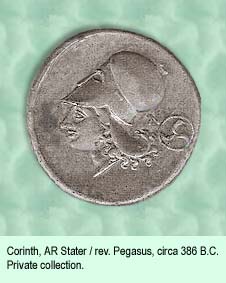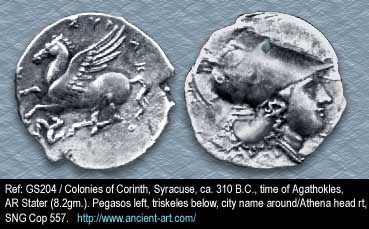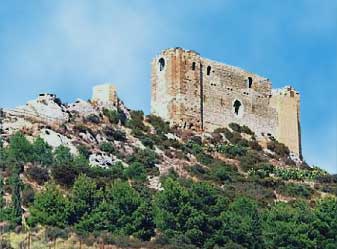|
|
Page IV |
|
|
|
|
|
|
 |
|
|
|
|
|
|
|
|
|
Megara
(Megaris), a definite maritime presence pioneering commercial
sea-routes, positioned between Attica and Corinth’s Isthmus,
circulated coinage applying Euboïc standards, offering a fourth
century B.C. hemidrachme with an Apollo obverse accompanying
a triskelis reverse. Experts suggest Megara minted early sixth
century B.C. having increased trade and defence fortifications
allowing its emergence as a city-state (circa
800 B.C.) quasi simultaneous with Athens. An era of Queens,
Tyre’s Princess Elissa-Dido founds Carthage — apparently
Jezebel’s grandniece (814-813 B.C.)
— whilst Sammuramut ruled Assyria, 810-805
B.C.
Following custom, Megarians created colonies:
Heraclea (Crimea), Thracian Byzantium (657 B.C.)
and another seventh-century Sicilian colony, Megara Hyblaea, established
near Syracuse. Byzantium found itself named after a distinguished
Megarian navigator, Byzas. The Peloponnesian War (431-404
B.C.) heralded Megara’s downfall and subjugation to Athens. |
|
|
|
|
|
|
|
|
|
|
Boasting over 200 tribes, the who’s
who of “harsh-wintered” Thrace presents complex routing.
Herodotus (425 BC), equally bemused,
wrote: “The Thracian people are the most numerous of the world”.
Wild Thrace, north of Greece and Macedonia, formerly spread over
areas of modern Bulgaria, Greece and Turkey. Unlike the Macedonians,
Thracians ignored Greek culture. Gold mines represented its great
asset. We shall settle for the few fine threads relating to the
symbol, whilst pointing out Euboea (above) possessed many colonies
therein.
This triskelis Odomanti silver specie forthcame
ca. 500-480 B.C.[
17 ] We know Cyrus’ Persians overran Thracian Lydia
up to southern Marmara shores. Darius I, launched in 512 what developed
into the king’s strangest battle, pursuing Scythian shadows.
En route he suffered attack by Odomanti Thracians in fear
of losing their independence. Eventually this did not prevent Persian
or Greek domination controlling the Thracian peninsula. Such events
put forward both Eastern and Grecian origins backing Thracian triskeles.
A Macedonian tetrobol reverse
of Acanthus circa 500, seems similarly
stylised to number 17 above. [ 55 ]
North of Hellas and west of Thrace, a turbulent, violent
land dropped as pupil centering the Cyclone’s eye, Macedonia,
once reigned in by sagacious Philip (382-336
B.C.), next whirled out beneath his phalanx.
Afterdays, a Thracian Macedonian would astound
the world: Alexander the Great. |
|
|
|
|
|
|
|
|
|
|
|
|
It is
believed Ionians of Asia Minor amongst the first inhabitants of Chios
(Hios / Khios) and that Homeric epics sourced inspiration from this
Northern Aegean Island famed for its school of bards. One theory (but only
a theory) explains the name “Chios” as Phoenician for the
word mastic.
The process of iron soldering apparently was discovered by Glaucus
(Glafkos) of Chios in the 7th century B.C. Possibly a leader
in the theory of democracy Chians established around 600
B.C. a Law titled Megali Ritra or “Great Clause”.
From this text democracy would blossom . Later, Hippocrates of Chios
would establish a foundation for geometry , circa
470-410 . The Island's procession of exceptional sculptors
point to one in particular, Achermos, designated as the creator in
stone of Nike, winged goddess of victory, often accompanying triskelions.
* 22
Famous for mastic and wine, Chians welcomed Alexander the Great's
rule and Macedonia's influential head-of-Herakles coin having Zeus
enthroned on the reverse. Minted during Alexander's lifetime and decades
thereafter as international coinage, these were struck throughout
the empire, some with triskelions as in Perga and Phaselis noted here.
A series of “Alexanders” as we call them, were issued on
the Island of Chios, one such bearing the triskelis beneath Zeus'
outstretched arm [
73 ] *21. After Alexander's death Chios
formed part of the Macedonian State. Theopompos, Chio's renowned historian
had joined Alexander, recording his deeds. |
|
|
 |
|
|
|
|
|
|
|
 |
|
|
|
|
|
|
|
|
|
|
|
|
|
|
|
The pearls adorning
Magna Graecia’s ampyx were Greek settlements sprouting in Italy,
appearing around the eight century B.C, but oftentimes these hung
as pearls of tears and discord. |
|
|
|
|
|
|
|
|
|
|
|
|
The colonies following Corinth's monetary
system were: Syracuse, Ambrakia (Arta), Anactorium, Dyrrhachium
(Durazzo) and Terina. *6
Fourth and third
century B.C. tetradrachmas of Syracuse
place Nike, goddess of victory alongside a trophy, a triskelis hovering
aloft. Additional issues poise her whipping forth a galloping quadriga
beneath the symbol seemingly in chase. Certain such coins show it
appearing to tight-rope race along Nike’s horse-whip
[
18 ].The
Arnoldi Forni Catalogue terms this triskelis: a “triquetra
of legs”. The following Treviri issue exemplifies Celtic styling
of the galloping quadriga, a favourite amongst Celts. *7
[
19 ] Stepping
behind her leading Corinthian sister [
15 ] comes a Syracusian silver stater shown here by permission
of Guy Clark — www.ancient coins.com [
21 ] |
|
|
 |
|
|
|
|
|
|
|
 |
|
|
|
|
|
|
|
|
|
|
|
|
|
|
|
A Corinthian colony
founded 734 B.C., Syracuse in Cicero’s
opinion stood finest and largest of all Greek cities. Fondly remembered
is her imaginative citizen Archimedes. The Syracusian’s famed
“ quadriga “ above (18), similarly appeared throughout many
Sicilian cities such as Himera, Agrigentum and Camarina. Such issues
blossomed under deft-fingered fifth century master engravers (celators)
: Mai, Exakestidas, Plynaenus and Phrygillos…..the list is long.
Part 1 shows a Syracusian coin of the Agathokles period, 317-289
B.C. This silver tetradrachm dated circa
305-295 B.C. portrays a wreathed head of Kore while the reverse
sees Nike erecting a trophy. Triskeles occasionally position themselves
elsewhere rather than topping the trophy and furthermore Tinoleontic
bronze litras (344-336 B.C.) see the
symbol take a primary role, completely filling certain reverses behind
obverse laureate heads of Zeus. |
|
|
|
|
|
|
|
|
|
|
The
Cleveland Museum of Art describes an exhibition ceramic bowl , ca.
610-600 B.C. as follows: |
|
|
|
|
|
|
|
|
|
|
|
|
“This deep bowl for
the mixing of wine was made in Gela, but the inspiration for
its shape and decoration derives from an Eastern Greek model. The
bottom of the bowl's exterior depicts the triskeles, a Near Eastern
motif composed of three bent legs converging in a circular area at
the center.” *8 |
|
|
 |
|
|
|
|
|
|
|
|
|
|
|
|
|
|
|
Befittingly, the bowl described reposes midst
the inventory of Agrigento’s
Regional Archaeological Museum. Pindar in the fifth century praised
this city’s beauty. [
42 ] Beneath Gela’s touch it belatedly arose 581
B.C. and was named Akragas
(Akracas). Desipite this delay, the colony developed nevertheless
into one of the wealthiest, vying with Syracuse and Athens. Confirming
this success Akragas proudly “stamped” Zeus’s majestic
eagle upon local coinage. South of today’s Agrigento (Agrigentum),
a sixty kilometres bird’s flight from Gela, lays the Akragas
Unesco heritage site. Its circa 154 A.D.
bronze triskelis currency appears unusually late under Roman rule,
Agrippa’s head dominating obverses.
The first Punic War brought Rome victory over Carthage following
a six month siege of Agrigentum, undertaken 262
B.C. The Romans dispossessed and enslaved Agrigentum’s
entire population, the colony’s definitive end, presaging Rome’s
control over Sicily.
Gela and the Island of Rhodes founded Akragas. Gela
in turn was founded (according to Thucydides) 680-690
B.C., through Crete and Rhodes.
Though outmatching Syracuse (600’s B.C.),
positioned at cross-spears between Greeks and Carthaginians brought
about Syracusian rule and later that of Carthage. Obtaining silver
via grain exports, Gela emerged as a minting city around 490
(the British Museum suggests the 6th century
B.C) a considerable advantage when paying Greek mercenaries
warding off Carthaginians who destroyed it nevertheless, in 405.
[
57 ] 282 B.C. the Mamertini
from Messana destroyed the city. |
|
|
|
|
|
|
|
|
|
|
Panamoros,
(Panormus and several other spelling variations) grew into a city
Phoenicians colonized. We know it today as Palermo, a name derived
from its later Arab name. Proof Magna Graecia records a civilization
rather than political cohesion, this city resisted numerous attacks
her covetous neighbour Syracuse initiated, yet the triskelis was
common to both [ 22 ],
Rome maintaining it thereafter. (see Rome below). Nearby Iaetia
issues commenced circa 210 B.C. Their
bronze coins with triskelis display a Gorgoneion head [
23 ].
An example is the full-legged figure heading this exposé.
Sicilian museums : http://www.sicilynet.it/articles/Museums.htm
|
|
|
|
|
|
|
|
|
|
|
|
|
|
|
|
|
|
|
The seventh
century B.C. witnessed Greeks colonizing Italy’s southern
mountainous yet fertile regions, adventurously founding numerous cities.
However they progressively succumbed either to self-inflicted internecine
strife or to non-Greek Samnium Lucanians.
These were Oscan-speaking Samnites originating from Central and Southern
Italy. Periodically enjoying acceptable terms with Greek and Phoenician
Colonies, Lucanians caught the art of striking coins in the 4th
century B.C.
Specialists state prosperous Sybaris
one of the first to issue coins. Italy’s Achaean colony and Velia’s
staunch ally, founded say some by Rhodians, others by Poseidon’s
sunken Helike (Helice) about 720 B.C.,
collapsed when Croton attacked 510 B.C. A
policy of liberty had characterized Sybaris whose inhabitants were
Achaeans, Troezenians and others. Finally, 443-446
B.C., Pericles accepting their request readied a fresh expedition
chosing mixed Greek colonists, future founders of Thourioi
(Thurii) nearby destroyed Sybaris. On board arrived a famed immigrant,
Herodotus, “father of History” who probably encountered
thence, fellow thinkers such as Empedocles of Akragas and Protagoras.
|
|
|
|
|
|
|
|
|
|
|
|
|
|
Thourioi soon prospered,
attracting new settlers particularly Peloponnesians striking a 443-425
coin portraying the popular galloping biga and charioteer, with a
triskelis. Later issues (425-400 B.C.)
present a Gorgoneion centred triskelis while third century issues
place the symbol hovering behind enthroned Nike. By 390
trouble started with the Lucanians who defeated the colonists. Worse
came when Hannibal gutted the city (204)
leaving Thourioi a depopulated shell. Though thought buried beneath
a Roman colony, the city’s original location is left suspended
to conjecture. |
|
|
|
|
|
|
|
|
|
|
Starbo notes, Silarus,
named after the river, niched in the Tarentum Gulf, took shape under
Troezenian and Achaeans rehabilitating the destroyed Sybaris site.
Herodotus describes Silarus as an enterprising city towards 540
B.C. when nearby Velia came about. Lucanians eventually overcame
the place, exceptionally allowing Greek immigrants to remain.
Poseidonia, a daughter colony of Sybaris founded during the seventh
century B.C., just twenty miles from Velia, conceived a triskelis
coin as a note in their Poseidon series. [
41 ] Early fourth century, the city fell to the Lucanians and
thereafter, named Paestum. Malaria
and ninth century Arab raids presumably caused this city’s disappearance.
[
56 ] |
|
|
|
|
|
|
|
|
|
|
|
|
Velia
pairs a lion of its Eastern origins with triskeles. The symbol this
occasion rotates ankle-winged.
[ 40 ] The coin represents the venerable town founded circa
540 B.C. by Greek Phocaeans escaping
Persian rule or so certain historians believe and according to Herodotus,
those initiating navigation about Adriatic, Tyrrhenian and Iberian
coastal waters *15. Phocaeans competed with
Etruscans in seamanship and weapon production. Ultimately, the foregoing,
using their Phoenician alliance, destroyed Phocaean trade-expansion.
Apparently the new colonists transplanted their
own Asian weight system (the Phocaic standard) having early grasped
the new Lydian art of coining money when still occupying their city
of origin, Phocaea, forty miles north of Smyrna. Stylistically their
art and coins direct towards Asia Minor. Unlike their unlucky sister-cities,
Velia suffered no Lucanian takeover. |
|
|
 |
|
|
|
|
|
|
|
|
|
|
|
|
|
|
|
Bruttium
is neither Lucania nor Magna Graecia after a term, yet the triskelis
likely emerged hither through Terina founded under Croton but overtaken
around 356 B.C. by the Bruttians. These
were Italy’s original inhabitants as were Lucanians from whom
they separated around 356. Roughly representing
today’s Calabria, they overtook certain Greek colonies, adopting
Greek speech and culture including coin production. Terina’s
coinage, initiated around 480 B.C., depicts
a local water-Nymph Terina, a triskelis [ 52
] behind her neck, while Nike dominates reverses, holding a
dove. A Kaulonia silver diobol circa 500-480
B.C. offers a lanky-legged triskelis entirely filling its reverse.
[
70 ]
Set against Roman expansion Lucanians stiffly resisted but lost footing
272 B.C. Determined, they strove anew
in 216 B.C., joining Phoenicia’s
Hannibal. Strabo noted: Sulla would never rest till all Samnites disappeared;
he would leave none alive bearing a Samnite name. Sulla stated: “Romans
would have scarce peace were such a race to remain in Italy.” |
|
|
|
|
|
|
|
|
|
|
“We have
compelled all lands and seas to open paths for our valour and have
everywhere planted eternal memorials of our friendship and our enmity”
wrote Thucydides (460-400 B.C.) . |
|
|
|
|
|
|
|
|
|
|
|
|
|
|
|
|
|
|
|
|
|
|
|
|
|
|
|
|
|
|
|
|
|
|


















